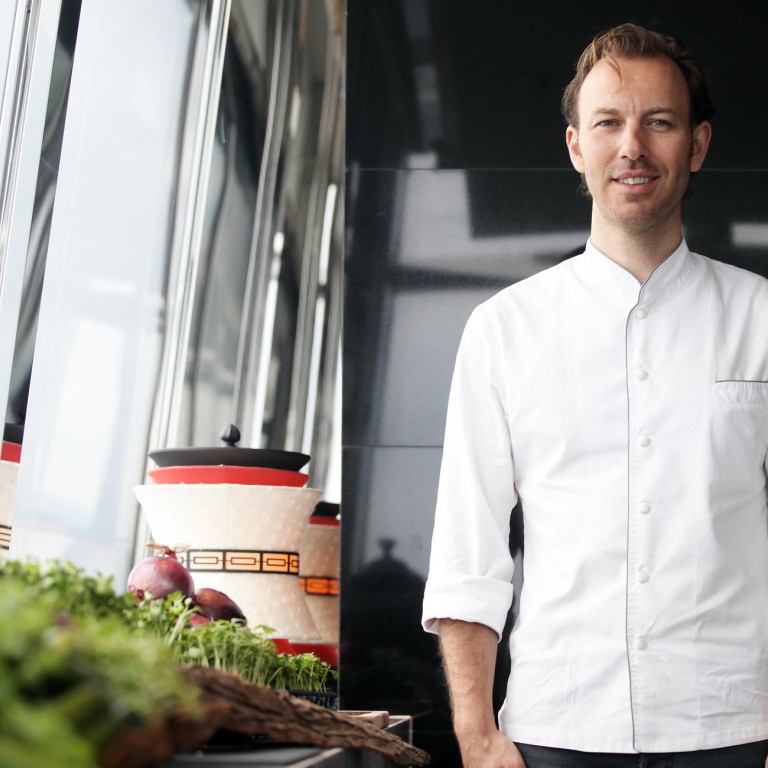
Mads Refslund, formerly of Noma, brings Nordic Cuisine to the Ritz-Carlton
Chef Mads Refslund helped rediscover the natural flavours of Nordic cuisine - then took the idea to the New World, writes Mischa Moselle
Danish chef Mads Refslund can trace his fascination with food back to a home-made pizza. But he's best known for something that's closer to his roots: popularising New Nordic Cuisine at his New York restaurant Acme.
Refslund is in Hong Kong for The Ritz-Carlton's food and wine festival, and his dinner menus tonight through to Sunday showcase the New American and New Nordic cooking of Acme, which he founded in 2011.
Refslund describes the food from Acme as family style, designed for sharing and for being eaten with the hands. The relaxed style extends to his wearing jeans in the kitchen. Typical dishes on The Ritz-Carlton menu include pork crackling and parsley, a very Danish combination, tweaked with seaweed; cucumber and buttermilk are enlivened with horseradish.
It's stupid just to buy the usual herbs, when you can learn something by looking at nature and get more inspired
Organic chicken grilled in hay comes with green asparagus, baby kelp seaweed and salted egg yolk. Diners at Acme might also try items such as sea bream, green almonds and porcini or sea urchin with eggs and cauliflower. "This is daring food, and it should start a conversation," says Refslund.
These combinations bear the hallmarks of the groundbreaking food at Noma, the restaurant he co-launched with chef René Redzepi and culinary entrepreneur and chef Claus Meyer in 2003. Before starting Noma, Refslund and Redzepi, who met at catering college, took a trip around Iceland, Norway, Sweden and the Faroe Islands to discover new ingredients and dishes. Their travels were later catalogued in Redzepi's book .
Redzepi, Meyer and Refslund were instrumental in launching New Nordic Cuisine, a style of cooking that uses foraged ingredients such as wild berries and seaweed. Menus at Noma also made use of ingredients and techniques that had not been used for 200 years. Some even dated back to Viking times.
Six months after Noma opened, Refslund decided that the kitchen was too small for two chefs and quit, although he says he remains on friendly terms with Redzepi, who is now an internationally acclaimed chef.
Noma, which was voted the world's best restaurant for three years in a row, put Scandinavian cooking on the map, while Refslund worked in various other notable restaurants in Denmark.
He opened his own eatery, called MR Restaurant, which was well regarded, although financial problems led to its closure in 2010. Refslund then started a vegetable farm with Meyer and has been one of the most forceful advocates of New Nordic Cuisine.
On a trip to the US, the Dane found himself arguing with a waiter after misunderstanding the tipping system. But his connection to Noma was revealed, and the next day he was discussing a new restaurant idea with the owner, a project that became Acme.
As with Noma, foraging and using local ingredients are a priority at Acme, which serves only produce from the New England region. The restaurant employs two full-time foragers and Refslund himself goes foraging once or twice a week if he has time. "It's stupid just to buy the usual herbs, when you can learn something by looking at nature and get more inspired," he says.
The chef and his team forage dock leafs from Long Island to make a bitter green sauce and, in another example of keeping a local flavour, will introduce the island's famed duck to the menu in the autumn.
Foraging is impractical for a three-day stint in Hong Kong, meaning that oak bark-infused ice cream with pine shoots has to substitute oak chips, and the sweet shrimp and bison tartar becomes raw beef with beetroot and fermented cherries.
Refslund's itch to cook became apparent from an early age. His parents were divorced and Refslund lived with his father, who worked nights. That meant the youngster sometimes cooked for himself. But he and his father also liked to cook together.
Refslund's youthful cooking certainly impressed his mother: at the age of 12 he made the pizza that started it all. His mother liked it so much she framed and hung a slice of it on the wall until it turned mouldy.
Almost three decades later, the chef still seems embarrassed by his mother's enthusiasm and is reluctant to confirm the anecdote. "Do we have to talk about that?" he says.
Refslund's first job was in a hotel in genteel Gentofte, a small town near Copenhagen, cooking Danish classics which included the country's takes on liver pates, and blood sausages.
His career has zigzagged between traditional restaurants and the more innovative style of Noma. But he says he always returns to Danish tradition in one form or another. Danish cooking and presentation techniques are almost on a par with those of Japan in their devotion to highlighting the purity of flavour and beauty of high quality ingredients.
At Acme, Refslund takes large carrots and cooks them for five hours in butter and pine leaves until they are completely caramelised.
The root is then sliced and served with lardo and fresh carrot juice. The aim is to "take a carrot and showcase it as the best it can be", he explains.
The chef is already contemplating his next restaurant - one that will be promoting the historic diet of the Native Americans who occupied the area before the European colonists arrived. He hopes to bring this cuisine to prominence, as he did with Nordic food.
But even so, Refslund never strays too far from his roots, it seems. This weekend's dinners feature a "tuna pizza".
For more information on The Ritz-Carlton's food and wine festival, visit ritzcarlton.com



